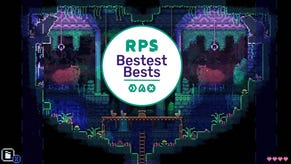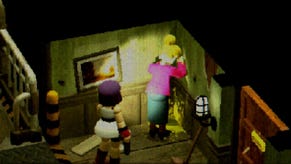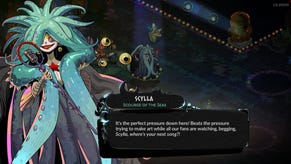Wot I Think: War For The Overworld
Dungeon Keeper 2.5
Dungeon Keeper has always felt important to me, and I’ve rarely analysed why, for the same reason I don’t question why I like cheddar cheese or very tall buildings. For my young sensibilities, it was the right game the right time, and as such it feels like it’s almost always been there: “I like Dungeon Keeper” is simply something I’ve always been able to say. Unfortunately, this also means I recognise when a game isn’t Dungeon Keeper, and it’s very hard to draw a distinct dividing line between adroitly noticing that something feels off and a deep-set resistance to any aspect of it changing even slightly.
That was my disclaimer of sorts: please keep it in mind for the rest of this piece. War For The Overworld is an unofficial sequel to the late-90s Dungeon Keeper games, although perhaps that’s going too far. It might be more accurate to say it’s a remake of Dungeon Keeper II, tweaked to have a less rigid structure, a mild graphics boost and with every unit and building replaced with a close analogue that should keep Dungeon Keeper keepers EA at bay.
Dungeon Keeper, to belatedly recap for the already confused, was a game in which you take the role of malevolent architect and manager of an underground lair, in which assorted beasties are trained and catered for with the eventual aim of wiping out invading ‘heroes’ or rival keepers. It offered a far more straightforward and limited take of the dig-to-design ethos long before Minecraft did it, and it threw in real-time strategy battles in which you had only limited control of minions who didn’t entirely want to be there.
War For The Overworld, at heart, is that again. The key beats are brought across intact: tag blocks to have your worker minions go and mine them, drag oblongs to construct assorted rooms within spaces you’ve opened up, build traps and research spells to increase your offence and defence possibilities. Much of Overworld feels, satisfyingly, like second nature: the basic, essential feel of Dungeon Keeper is there. Something in me really, really enjoys drawing lines and rectangles on the rock then seeing it slowly chipped away into a workable space, and I’m relieved that Overworld has recreated rather than remixed this. If I don’t look too closely, at times I’m right back there in 1997.
As much as I’d love to claim I’m a tireless pursuant of The New, the reality is that, yes, in this instance I want a shinier remake of Dungeon Keeper. While this means I find Overworld intrinsically compelling, it also means I’m troubled by its changes. These are focused on two fronts, the first of which is the creature design. Overworld has to play it safe here, as to sail too close to the copyright wind would have seen the whole project shut down, but I really do struggle to feel that it’s imbued its characters with as much distinctiveness and personality as Dungeon Keeper did.
Then again, and this is very important to keep in mind, what seemed distinctive and characterful to a teenage boy in the late 90s may well not have been distinctive and characterful by any other yardstick. Big, fat, red farting demons were the height of wit to a kid who only read Pratchett books at the most superficial level, after all, and it’s true to say there are plenty of DK creatures I can’t quite recall the names of if they’re not in front of me. But what I could and can do is tell what everything does and what its non-combat purpose is at a glance; that isn’t entirely the case with Overworld. The defining characteristics of so many of them are 'brown and spiky.' There are a couple which stand out, like the guy with an anvil for a head and the Succubi, the unit closest to the DK original (The Mistress, a comedy S&M character who went on to be cynically used at the lad-pandering forefront of DK2’s marketing), but all told it’s this indistinct throng.
Clearly I can tell what everything is if I look closely, but there is this double-whammy of sameness to many of them and in turn not really caring about them. They don’t feel like little, ill-tempered characters in my dungeon, they simply feel like fodder. Maybe that’s appropriate – I’m not roleplaying as a world-shattering tyrant with a secret heart of gold, after all – but it’s this slight blandness I can’t move past. Completely gone is any sense that my creatures are on the verge of killing each other; they’ll get unhappy if needs aren’t met, but there isn’t that Jurassic Park feel, that things could go horribly wrong at any given moment due to the absurdity of thinking I can tell monsters what to do.
I also struggle with the presentation, specifically in terms of user interface. The edges of the screen are bombarded by a mish-mash of buttons and numbers, and while not at all overwhelming, it’s not terribly attractive and seems to have prioritised ‘get everything up there somewhere’ over actual usability. For instance, trying to click the little Cancel Rally button usually ends up with me tagging a bit of rock instead, because it’s just floating on top of the main screen and the cursor can’t always tell whether I’m clicking the button or what’s underneath it.
Then there’s the sprawling new research interface, reflective of Overworld’s noble urge to move DK away from a linear tech tree into a strategic, pick-what-you-need one, but which in practice is a splurge of similar-looking icons which requires far too much squinting to decipher. Once they are researched, the game then sub-divides spells into four separate categories on the main UI, and again it’s a minor feat of memory or tooltip-browsing to keep tabs on exactly what is where.
A great many of the spells and buffs in here are realistically only relevant to multiplayer or high-difficulty skirmish too, and incidental confusions if, like me, you’re in this for the stoic base-building of singleplayer. I appreciate what this tech tree – known as The Veins of Evil – is trying to do, in terms of liberating DK from being a straight romp to a predetermined finish line, but it looks and feels like it went slightly too far, like a long list of ideas didn’t quite get whittled into a shortlist. Or, perhaps, that the focus has been heavily on expanding the micro, and not anything like so much on growing or evolving the essential dungeon construction aspect.
This is reflected too in some of the levels, which have a manic, all-out quality that presupposes a certain degree of expertise that people who’ve never played Dungeon Keeper competitively may not have. In terms of presenting a remixed and sterner challenge to people who have drained the DK games of every last drop, I suppose this is hard to argue with, but for me it’s a bit like visiting an old friend only to discover they’ve got enormous tribal tattoos on their arms, animal heads mounted to their walls and keep giving me a look which says “c’mon then, you wanna throw down?”
All of this combines into a game which feels less like a living dungeon and much more like a fairly steely RTS I have to put a great deal of learning time into. I can absolutely understand why this might be – this is a game made by and for people who are already very, very good at Dungeon Keeper – but I feel like some of the essential tinkerer’s appeal is undermined by this move to great precision and fine understanding of every mechanic. I only care about my creatures as a resource, and I don’t think about them as actually living here: this is the loss I most mourn.
I should also mention that there are a fair few bugs at launch, a few of which have required me to restart levels, and some modes remain unfinished. It's being patched regularly and the devs seem open and humble about the state of affairs so I'm reticent to beat it too heavily with that particular stick, but if you intend to buy it now please at least go in aware that it is, frankly, not quite finished. It's improved noticeably in the time since I started playing it for this piece, but clearly there are no guarantees that all issues will get ironed out.
For all that, War For The Overworld is closer than I ever dared dream to a new Dungeon Keeper game. The perspective, the cleanness of construction, the echoing sound of solitary mining, the audio duvet that is the returning voice of Richard ‘Daddy Pig’ Ridings as narrator, the lively pleasure of a room’s contents simply popping into being when you drag out its shape, the way the treasure slowly piles up everywhere, the laconic power of grabbing creatures by the scruff of the neck and depositing them wherever you want them... To get that stuff right is a triumphant and enormous achievement for a self-motivated first-time team who started off as fans and then brought about the nearest thing we may ever have to DK3. Core aspects of Overworld feel like a cuddle, and for all its (satirical and broad) themes of darkness and torture, a cuddle is what I want from Dungeon Keeper games.
So yes, an awful lot of what makes Dungeon Keeper Dungeon Keeper is in here, and I respect the hell out of that, but there’s a certain degree of elegance missing due to the micro-intensive method it’s chosen to move the dial towards. For those fans who, unlike me, have kept on playing Dungeon Keeper II regularly in the many years since release, I’m sure this big blow-up in complexity is a gift. For those who, like me, only revisit occasionally, slipping on old shoes just for the pleasure of it, it does feel like the game got dragged off somewhere else, somewhere more intense, fiddly and competitive. I shall leave it to you to decide whether I’m being a noble keeper of the flame or just an old man.















